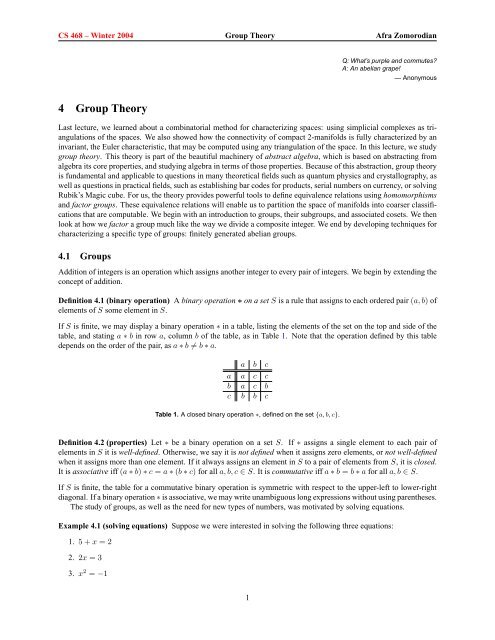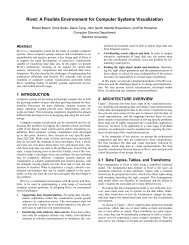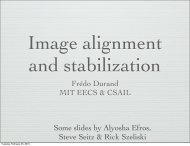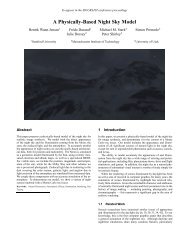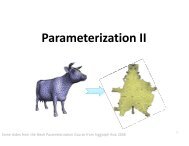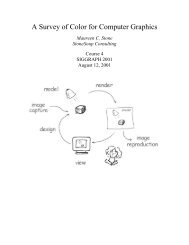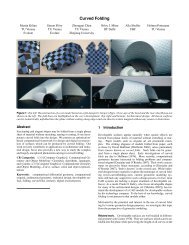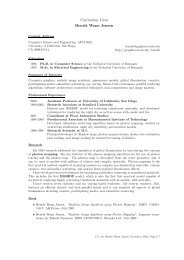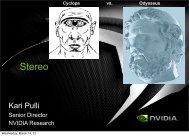Topology for Computing Mini-Kurse pdfsubject - Computer Graphics ...
Topology for Computing Mini-Kurse pdfsubject - Computer Graphics ...
Topology for Computing Mini-Kurse pdfsubject - Computer Graphics ...
Create successful ePaper yourself
Turn your PDF publications into a flip-book with our unique Google optimized e-Paper software.
CS 468 – Winter 2004 Group Theory Afra Zomorodian<br />
4 Group Theory<br />
Q: What’s purple and commutes?<br />
A: An abelian grape!<br />
— Anonymous<br />
Last lecture, we learned about a combinatorial method <strong>for</strong> characterizing spaces: using simplicial complexes as triangulations<br />
of the spaces. We also showed how the connectivity of compact 2-manifolds is fully characterized by an<br />
invariant, the Euler characteristic, that may be computed using any triangulation of the space. In this lecture, we study<br />
group theory. This theory is part of the beautiful machinery of abstract algebra, which is based on abstracting from<br />
algebra its core properties, and studying algebra in terms of those properties. Because of this abstraction, group theory<br />
is fundamental and applicable to questions in many theoretical fields such as quantum physics and crystallography, as<br />
well as questions in practical fields, such as establishing bar codes <strong>for</strong> products, serial numbers on currency, or solving<br />
Rubik’s Magic cube. For us, the theory provides powerful tools to define equivalence relations using homomorphisms<br />
and factor groups. These equivalence relations will enable us to partition the space of manifolds into coarser classifications<br />
that are computable. We begin with an introduction to groups, their subgroups, and associated cosets. We then<br />
look at how we factor a group much like the way we divide a composite integer. We end by developing techniques <strong>for</strong><br />
characterizing a specific type of groups: finitely generated abelian groups.<br />
4.1 Groups<br />
Addition of integers is an operation which assigns another integer to every pair of integers. We begin by extending the<br />
concept of addition.<br />
Definition 4.1 (binary operation) A binary operation ∗ on a set S is a rule that assigns to each ordered pair (a, b) of<br />
elements of S some element in S.<br />
If S is finite, we may display a binary operation ∗ in a table, listing the elements of the set on the top and side of the<br />
table, and stating a ∗ b in row a, column b of the table, as in Table 1. Note that the operation defined by this table<br />
depends on the order of the pair, as a ∗ b �= b ∗ a.<br />
a b c<br />
a a c c<br />
b a c b<br />
c b b c<br />
Table 1. A closed binary operation ∗, defined on the set {a, b, c}.<br />
Definition 4.2 (properties) Let ∗ be a binary operation on a set S. If ∗ assigns a single element to each pair of<br />
elements in S it is well-defined. Otherwise, we say it is not defined when it assigns zero elements, or not well-defined<br />
when it assigns more than one element. If it always assigns an element in S to a pair of elements from S, it is closed.<br />
It is associative iff (a ∗ b) ∗ c = a ∗ (b ∗ c) <strong>for</strong> all a, b, c ∈ S. It is commutative iff a ∗ b = b ∗ a <strong>for</strong> all a, b ∈ S.<br />
If S is finite, the table <strong>for</strong> a commutative binary operation is symmetric with respect to the upper-left to lower-right<br />
diagonal. If a binary operation ∗ is associative, we may write unambiguous long expressions without using parentheses.<br />
The study of groups, as well as the need <strong>for</strong> new types of numbers, was motivated by solving equations.<br />
Example 4.1 (solving equations) Suppose we were interested in solving the following three equations:<br />
1. 5 + x = 2<br />
2. 2x = 3<br />
3. x 2 = −1<br />
1
CS 468 – Winter 2004 Group Theory Afra Zomorodian<br />
The equations imply the need <strong>for</strong> negative integers Z − , rational numbers Q, and complex numbers C, respectively.<br />
Recalling algebra from 8th grade, I solve equation (1) above, listing the properties needed at each step.<br />
5 + x = 2 Given<br />
−5 + (5 + x) = −5 + 2 Addition property of equality<br />
(−5 + 5) + x = −5 + 2 Associative property of addition<br />
0 + x = −5 + 2 Inverse property of addition<br />
x = −5 + 2 Identity property of addition<br />
x = −3 Addition<br />
We take all the properties we need to solve this equation to define a group.<br />
Definition 4.3 (group) A group 〈G, ∗〉 is a set G, together with a binary operation ∗ on G, such that the following<br />
axioms are satisfied:<br />
(a) ∗ is associative.<br />
(b) ∃e ∈ G such that e ∗ x = x ∗ e = x <strong>for</strong> all x ∈ G. The element e is an identity element <strong>for</strong> ∗ on G.<br />
(c) ∀a ∈ G, ∃a ′ ∈ G such that a ′ ∗ a = a ∗ a ′ = e. The element a ′ is an inverse of a with respect to the operation ∗.<br />
If G is finite, the order of G is |G|. We often omit the operation and refer to G as the group.<br />
The identity and inverses are unique in a group. We may easily show, furthermore that (a∗b) ′ = b ′ ∗a ′ , <strong>for</strong> all a, b ∈ G<br />
in group 〈G, ∗〉.<br />
Example 4.2 〈Z, +〉, 〈R − {0}, ·〉, 〈R, +〉, are all groups.<br />
� Note that only one operation is allowed <strong>for</strong> groups, so we choose either multiplication or addition <strong>for</strong> integers,<br />
<strong>for</strong> example. When we do so, the other operation is not even defined. So, do not use it!<br />
We are mainly interested in groups with commutative binary operations.<br />
Definition 4.4 (abelian) A group G is abelian if its binary operation ∗ is commutative.<br />
We borrow terminology from arithmetic usually <strong>for</strong> abelian groups, using + or juxtaposition <strong>for</strong> the operation, 0 or<br />
1 to denote identity, and −a or a −1 <strong>for</strong> inverses. It is easy to list the possible structures <strong>for</strong> small groups using the<br />
following fact, derived from the definition of groups: each element of a finite group must appear once and only once<br />
in each row and column of its table. Using this fact, Table 2 shows all possible structures <strong>for</strong> groups of size 2, 3, and 4<br />
in Table 2. There are, in fact, three possible groups of size 4, but only two unique structures: we get the other one by<br />
renaming elements.<br />
Z2 e a<br />
e e a<br />
a a e<br />
Z3 e a b<br />
e e a b<br />
a a b e<br />
b b e a<br />
Z4 0 1 2 3<br />
0 0 1 2 3<br />
1 1 2 3 0<br />
2 2 3 0 1<br />
3 3 0 1 2<br />
Table 2. Structures <strong>for</strong> groups of size 2, 3, 4.<br />
V4 e a b c<br />
e e a b c<br />
a a e c b<br />
b b c e a<br />
c c b a e<br />
Example 4.3 (symmetry groups) An application of group theory is the study of symmetries of geometric figures. An<br />
isometry is a distance-preserving trans<strong>for</strong>mation in a metric space. A symmetry is any isometry that leaves the object<br />
as a whole unchanged. The symmetries of a figure <strong>for</strong>m a group. A human, abstracted in Figure 1 (a) as a stick figure,<br />
has only two symmetries: the identity, and reflection along the vertical line shown. It is immediate that a human’s<br />
group of symmetry is Z2, as this is the only group with two elements. The letter “H” (b) has three different types of<br />
symmetries shown: reflections along the horizontal and vertical axes, and rotation by 180 degrees. If we write down<br />
2
CS 468 – Winter 2004 Group Theory Afra Zomorodian<br />
(a) Humans have Z2 symmetry<br />
a<br />
Figure 1. Two figures and their symmetry groups.<br />
c<br />
(b) The letter “H” has V4 symmetry<br />
(a) View of column (b) Motif & Design<br />
Figure 2. Tiled Design from Masjid-e-Shah in Isfahan, Iran (a) repeats the prophet’s name (b) to obtain a figure (c) with Z4 symmetry.<br />
the table corresponding to compositions of these symmetries, we get the group V4, one of the two groups with four<br />
elements, as shown in Table 2.<br />
Designers have used symmetries throughout history to decorate buildings. Figure 2 (a) shows a view of a column<br />
of Masjid-e-Shah, a mosque in Isfahan, Iran, that was completed in 1637. The design in the center of the photo<br />
pictorializes the name of the prophet of Islam, Mohammad as the motif in a design (b). This figure is unchanged by<br />
rotations by multiples of 90 degrees. Letting e, a, b, c be rotations by 0, 90, 180, and 270 degrees, respectively, and<br />
writing down the table of compositions, we get Z4, the other group with four elements in Table 2. That is, the design<br />
has Z4 symmetry.<br />
4.2 Subgroups and Cosets<br />
As <strong>for</strong> sets, we may try to understand groups by examining the building blocks they are composed of. We begin by<br />
extending the concept of a subset to groups.<br />
Definition 4.5 (induced operation) Let 〈G, ∗〉 be a group and S ⊆ G. If S is closed under ∗, then ∗ is the induced<br />
operation on S from G.<br />
Definition 4.6 (subgroup) A subset H ⊆ G of group 〈G, ∗〉 is a subgroup of G if H is a group and is closed under<br />
∗. The subgroup consisting of the identity element of G, {e} is the trivial subgroup of G. All other subgroups are<br />
nontrivial.<br />
We can identify subgroups easily, using the following theorem.<br />
Theorem 4.1 H ⊆ G of a group 〈G, ∗〉 is a subgroup of G iff:<br />
3<br />
b<br />
a
CS 468 – Winter 2004 Group Theory Afra Zomorodian<br />
1. H is closed under ∗,<br />
2. the identity e of G is in H,<br />
3. <strong>for</strong> all a ∈ H, a −1 ∈ H.<br />
Example 4.4 [Z4] The empty set is a trivial subgroup of any group, including Z4. The only nontrivial proper subgroup<br />
of Z4 in Table 2 is {0, 2}. {0, 3} is not a subgroup of Z4 as 3 ∗ 3 = 2 �∈ {0, 3}, so the set is not closed under the binary<br />
operation stated in the table. In other words, the operation is not induced in the subset.<br />
Example 4.5 [trans<strong>for</strong>mations] In the first lecture, we talked about Felix Klein’s unifying definition of geometry and<br />
topology as the study of invariant properties under trans<strong>for</strong>mation. We may now state his full definition. The set of<br />
all trans<strong>for</strong>mations of a space <strong>for</strong>ms a group under composition. A geometry is the study of those properties of a<br />
space that remain invariant under some fixed subgroup of the full trans<strong>for</strong>mation group. The set of isometries <strong>for</strong>ms a<br />
subgroup of the full trans<strong>for</strong>mation group. The Euclidean geometry is the study of those properties left invariant under<br />
the group of isometries. Similarly, homeomorphisms <strong>for</strong>m a subgroup of the full trans<strong>for</strong>mation group, and topology<br />
is the study of invariants of spaces under this subgroup.<br />
Given a subgroup, we may partition a group into sets, all having the same size as the subgroup. The cosets are<br />
basically like the “evil” siblings of the subgroup we use to partition the group. They look very much like the subgroup,<br />
but are not groups themselves.<br />
Theorem 4.2 Let H be a subgroup of G. Let the relation ∼L be defined on G by: a ∼L b iff a −1 b ∈ H. Let ∼R be<br />
defined by: a ∼R b iff ab −1 ∈ H. Then ∼L and ∼R are both equivalence relations on G.<br />
Note that a −1 b ∈ H ⇒ a −1 b = h ∈ H ⇒ b = ah. We use these relations to define cosets.<br />
Definition 4.7 (cosets) Let H be a subgroup of group G. For a ∈ G, the subset aH = {ah | h ∈ H} of G is the left<br />
coset of H containing a, and Ha = {ha | h ∈ H} is the right coset of H containing a.<br />
For an abelian subgroup H of G, ah = ha, ∀a ∈ G, h ∈ H, so left and right cosets match. We may easily show that<br />
every left coset and every right coset has the same size by constructing a 1-1 map of H onto a left coset gH of H <strong>for</strong><br />
a fixed element g of G. If a subgroup’s left and right cosets match, we say that the subgroup is normal.<br />
Definition 4.8 (normal) A subgroup H of a group G is normal if its left and right cosets coincide, that is, if gH = Hg<br />
<strong>for</strong> all g ∈ G.<br />
Example 4.6 [Z4] As we saw in Example 4.4, {0, 2} is a subgroup of Z4. It is normal as Z4 is abelian. The coset of<br />
1 is 1 + {0, 2} = {1, 3}. The cosets {0, 2} and {1, 3} exhaust all of Z4.<br />
4.3 Factor Groups<br />
Given a normal subgroup, we would like to treat the cosets as individual elements of a smaller group. To do so, we<br />
first derive a binary operation from the group operation of G.<br />
Theorem 4.3 Let H be a subgroup of a group G. Then, left coset multiplication is well-defined by the equation<br />
(aH)(bH) = (ab)H, iff left and right cosets coincide.<br />
We can show that this multiplication is well-defined as it does not depend on the elements a, b chosen from the cosets.<br />
Using left coset multiplication as a binary operation, we get new groups.<br />
Corollary 4.1 Let H be a subgroup of G whose left and right cosets coincide. Then, the cosets of H <strong>for</strong>m a group<br />
G/H under the binary operation (aH)(bH) = (ab)H.<br />
Definition 4.9 (factor group) The group G/H in Corollary 4.1 is the factor group (or quotient group) of G modulo H.<br />
The elements in the same coset of H are said to be congruent modulo H.<br />
4
CS 468 – Winter 2004 Group Theory Afra Zomorodian<br />
Example 4.7 (Factoring Z6) The cyclic group Z6, on the left, has {0, 3} as a subgroup. As Z6 is abelian, {0, 3} is<br />
normal, so we may factor Z6 using this subgroup, getting cosets {0, 3}, {1, 4}, and {2, 5}. Figure 3 shows the table<br />
<strong>for</strong> Z6, ordered and colored according to the cosets. The color pattern gives rise to a smaller group, shown on the<br />
Z 6<br />
0<br />
3<br />
1<br />
4<br />
2<br />
5<br />
0<br />
0 3<br />
3 0<br />
1 4<br />
4 1<br />
2 5<br />
5<br />
3<br />
2<br />
1<br />
1 4 2 5<br />
4 1<br />
2 5<br />
5<br />
4<br />
2<br />
3 0<br />
0 3<br />
2<br />
5<br />
5<br />
2<br />
3 0<br />
0 3<br />
4 1<br />
1 4<br />
Figure 3. Z6/{0, 3} is isomorphic to Z3.<br />
right, where each coset is collapsed to a single element. Comparing this new group to the structures in Table 2, we<br />
observe that it looks very much like Z3, the group of order 3. That is, the two groups are isomorphic (we <strong>for</strong>malize<br />
this concept later in this lecture.) We write Z6/{0, 3} ∼ = Z3. Moreover, {0, 3} with binary operation +6 is isomorphic<br />
to Z2, as one may see from the top left corner of the table <strong>for</strong> Z6. So, we have Z6/Z2 ∼ = Z3. Similarly, Z6/Z3 ∼ = Z2,<br />
as shown in Figure 4.<br />
Z 6 0<br />
0<br />
2<br />
4<br />
1<br />
3<br />
5<br />
2 4<br />
0 2 4<br />
2 4 0<br />
4 0 2<br />
1<br />
3<br />
5<br />
3 5 1<br />
5 1 3<br />
1 3 5<br />
1<br />
3<br />
5<br />
3 5 1<br />
5 1 3<br />
2 4 0<br />
4<br />
0 2<br />
0 2 4<br />
Figure 4. Z6/{0, 2, 4} is isomorphic to Z2.<br />
� For a beginner, factor groups seem to be of the hardest concepts in group theory. Given a factor group G/H,<br />
the key idea to remember is that each element of the factor group has the <strong>for</strong>m aH: it is a set, a coset of H.<br />
Now, we could represent each element of a factor group with a representative from the coset. For example, the element<br />
4 could represent the coset {1, 4} <strong>for</strong> factor group Z6/{0, 3}. However, don’t <strong>for</strong>get that this element is congruent to<br />
1 modulo {0, 3}.<br />
4.4 Homomorphisms<br />
Having defined groups, a natural question that arises is to characterize groups: how many “different” groups are there?<br />
This is yet another classification problem and it is the fundamental question studied in group theory. Since we are<br />
interested in characterizing the structure of groups, we define maps between groups to relate their structures.<br />
Definition 4.10 (homomorphism) A map ϕ of a group G into a group G ′ is a homomorphism if ϕ(ab) = ϕ(a)ϕ(b)<br />
<strong>for</strong> all a, b ∈ G. For any groups G and G ′ , there’s always at least one homomorphism ϕ: G → G ′ , namely the trivial<br />
homomorphism defined by ϕ(g) = e ′ <strong>for</strong> all g ∈ G, where e ′ is the identity in G ′ .<br />
In other words, a homomorphism is a linear map, where linearity is defined relative to the group binary operation.<br />
Analogs of injections, surjections, and bijections exist <strong>for</strong> maps between groups. They have their own special names,<br />
however.<br />
5<br />
*<br />
*
CS 468 – Winter 2004 Group Theory Afra Zomorodian<br />
Definition 4.11 (mono-, epi-, iso-morphism) A 1-1 homomorphism is an monomorphism. A homomorphism that is<br />
onto is an epimorphism. A homomorphism that is 1-1 and onto is an isomorphism. We use ∼ = <strong>for</strong> isomorphisms.<br />
Isomorphisms between groups are like homeomorphisms between topological spaces. We may use isomorphisms to<br />
define an equivalence relationship between groups, <strong>for</strong>malizing our notion <strong>for</strong> similar structures <strong>for</strong> groups.<br />
Theorem 4.4 Let G be any collection of groups. Then ∼ = is an equivalence relation on G.<br />
All groups of order 4, <strong>for</strong> example, are isomorphic to one of the two 4 by 4 tables in Table 2, so the classification<br />
problem is fully solved <strong>for</strong> that order. We need smarter techniques, however, to settle this question <strong>for</strong> higher orders.<br />
Homomorphisms preserve the identity, inverses, and subgroups in the following <strong>for</strong>mal sense.<br />
Theorem 4.5 Let ϕ be a homomorphism of a group G into a group G ′ .<br />
1. If e is the identity in G, then ϕ(e) is the identity e ′ in G ′ .<br />
2. If a ∈ G, then ϕ(a −1 ) = ϕ(a) −1 .<br />
3. If H is a subgroup of G, then ϕ(H) is a subgroup of G ′ .<br />
4. If K ′ is a subgroup of G ′ , then ϕ −1 (K ′ ) is a subgroup of G.<br />
Homomorphisms also define a special subgroup in their domain.<br />
Definition 4.12 (kernel) Let ϕ : G → G ′ be a homomorphism. The subgroup ϕ −1 ({e ′ }) ⊆ G, consisting of all<br />
elements of G mapped by ϕ into the identity e ′ of G ′ , is the kernel of ϕ, denoted by ker ϕ.<br />
We illustrate the kernel in Figure 5. Note that ker ϕ is a subgroup by an application of the fourth statement of<br />
Theorem 4.5 as {e ′ } is the trivial subgroup of G ′ . Since the kernel is a subgroup, we may use it to partition G into<br />
cosets.<br />
Theorem 4.6 Let ϕ : G → G ′ be a homomorphism, and let H = ker ϕ. Let a ∈ G. Then the set<br />
ϕ −1 {ϕ(a)} = {x ∈ G | ϕ(x) = ϕ(a)}<br />
is the left coset aH of H, and is also the right coset Ha of H.<br />
The two partitions of G into left cosets and into right cosets of ker ϕ are the same, according to the theorem. That is,<br />
the kernel is normal.<br />
4.5 Finitely Generated Abelian Groups<br />
We are primarily interested in finitely generated abelian groups. These groups will arise as descriptions of the connectivity<br />
of topological spaces. To understand the structure of these groups, we utilize our usual approach: understand<br />
simple structures first, and try to construct complicated structures from these building blocks. We begin with cyclic<br />
groups, the simplest group there is.<br />
G<br />
ker ϕ<br />
ϕ<br />
G’<br />
Figure 5. A homomorphism ϕ: G → G ′ and its kernel.<br />
6<br />
e’
CS 468 – Winter 2004 Group Theory Afra Zomorodian<br />
Theorem 4.7 Let G be a group and let a ∈ G. Then, H = {a n | n ∈ Z} is a subgroup of G and is the smallest<br />
subgroup of G that contains a, that is, every subgroup containing a contains H.<br />
Definition 4.13 (cyclic group) The group H of Theorem 4.7 is the cyclic subgroup of G generated by a, and will be<br />
denoted by 〈a〉. If 〈a〉 is finite, then the order of a is |〈a〉|. An element a of a group G generates G and is a generator<br />
<strong>for</strong> G if 〈a〉 = G. A group G is cyclic if it has a generator.<br />
For example, Z = 〈1〉 under addition, and is there<strong>for</strong>e cyclic. We can also define finite cyclic groups using a new<br />
binary operation.<br />
Definition 4.14 (modulo) Let n be a fixed positive integer and let h and k be any integers. The remainder r when<br />
h + k is divided by n is the sum of h and k modulo n.<br />
Definition 4.15 (Zn) The set {0, 1, 2, . . . , n − 1} is a cyclic group Zn of elements under addition modulo n.<br />
This definition is the reason why we named the single group of order three and one of the groups of order four in<br />
Table 2 Z3 and Z4, respectively. We may fully classify cyclic groups, using the theorem below.<br />
Theorem 4.8 (classification of cyclic groups) Any infinite cyclic group is isomorphic to Z under addition. Any finite<br />
cyclic group of order n is isomorphic to Zn under addition modulo n.<br />
Consequently, we may use Z and Zn as the prototypical cyclic groups.<br />
We next extend the idea of a generator to multiple generators <strong>for</strong> a group. Each generator generates some portion<br />
of the elements. We put them together using intersection of groups.<br />
Theorem 4.9 The intersection of subgroups Hi of a group G <strong>for</strong> i ∈ I is again a subgroup of G.<br />
Let G be a group and let ai ∈ G <strong>for</strong> i ∈ I. There is at least one subgroup of G containing all the elements ai, namely<br />
G, itself. Theorem 4.9 allows us to take the intersection of all the subgroups of G containing all ai to obtain a subgroup<br />
H of G. Clearly, H is the smallest subgroup containing all ai.<br />
Definition 4.16 (finitely generated) Let G be a group and let ai ∈ G <strong>for</strong> i ∈ I. The smallest subgroup of G containing<br />
{ai | i ∈ I} is the subgroup generated by {ai | i ∈ I}. If this subgroup is all of G, then {ai | i ∈ I} generates G<br />
and the ai are the generators of G. If there is a finite set {ai | i ∈ I} that generates G, then G is finitely generated.<br />
Having defined what we mean by finitely generated groups, we may look at a complete description of their structure.<br />
Theorem 4.10 (direct products) Let G1, G2, . . . , Gn be groups. For (a1, a2, . . . , an) and<br />
(b1, b2, . . . , bn) in �n i=1 Gi, define (a1, a2, . . . , an)(b1, b2, . . . , bn) to be (a1b1, a2b2, . . . , anbn). Then �n group, the direct product of the groups Gi, under this binary operation.<br />
i=1 Gi is a<br />
� The definition defines its elements to be tuples made up from elements from each of the sets. It also defines its<br />
binary operation by utilizing the binary operations of all the groups. That is, in the product of the two tuples,<br />
aibi is the element in group Gi that the group binary operation assigns to it.<br />
The direct product is often written with the symbol ⊗ to distinguish it from the binary operation of the group (which<br />
may be indicated as a product.) Sometimes, it is called the direct sum, indicated by a ⊕. Although these symbols<br />
seem to be designed to scare non-specialists away, they do help to keep the distinction between different operations<br />
clear, especially when we have additional operations in advanced algebra. The following theorem gives a complete<br />
characterization of the structure of finitely generated abelian groups as the direct product of cyclic groups.<br />
Theorem 4.11 (fundamental theorem of finitely generated abelian groups) Every finitely generated abelian group<br />
is isomorphic to product of cyclic groups of the <strong>for</strong>m<br />
Zm1<br />
× Zm2 × . . . × Zmr × Z × Z × . . . × Z,<br />
where mi divides mi+1 <strong>for</strong> i = 1, . . . , r − 1. The direct product is unique; that is, the number of factors of Z is unique<br />
and the cyclic group orders mi are unique.<br />
7
CS 468 – Winter 2004 Group Theory Afra Zomorodian<br />
Note how the product is composed of a number of infinite and finite cyclic group factors. Intuitively, the infinite part<br />
captures those generators that are “free” to generate as many elements as they wish. This portion of the group is a free<br />
group that acts like a vector space. The group may be given a basis of generators from which we may generate the<br />
group. The number of generators is called the rank of the free group. The finite or “torsion” part, on the other hand,<br />
captures generators with finite order. This portion is like a strange vector space that does not allow us to move freely<br />
in every dimension. In fact, this portion is called a module. We do not have enough time in this course to discuss these<br />
structures in detail.<br />
Definition 4.17 (Betti number, torsion) The number of factors of Z in Theorem 4.11 is the Betti number β(G) of G.<br />
The orders of the finite cyclic groups are the torsion coefficients of G.<br />
Example 4.8 (V4) In Table 2, we listed the binary operations <strong>for</strong> the two different groups of order four. We now<br />
know Z4 to be the cyclic group under addition modulo four. It is already characterized in the <strong>for</strong>m specified by the<br />
fundamental theorem, so there is nothing <strong>for</strong> us to do. It is clear from the structure of V4 that it is not cyclic, that is, no<br />
single element generates it. Otherwise, it would simply be isomorphic to Z4 by Theorem 4.8. But V4 is a finite group,<br />
so it is finitely generated, and we should be able to characterize it according to the theorem. The only other way to<br />
get a direct product of cyclic groups with four elements is Z2 × Z2. This group must be isomorphic to either Z4 or<br />
V4 by our claim. By its definition, the order of each element in Z2 × Z2 is two. But Z4 has one element, namely the<br />
generator, with order four. There<strong>for</strong>e, Z4 � ∼ = Z2 × Z2 and it must be that V4 ∼ = Z2 × Z2. Let us check this fact by<br />
writing the table <strong>for</strong> the binary operation of Z2 × Z2.<br />
Z2 × Z2 (0, 0) (0, 1) (1, 0) (1, 1)<br />
(0, 0) (0, 0) (0, 1) (1, 0) (1, 1)<br />
(0, 1) (0, 1) (0, 0) (1, 1) (1, 0)<br />
(1, 0) (1, 0) (1, 1) (0, 0) (0, 1)<br />
(1, 1) (1, 1) (1, 0) (0, 1) (0, 0)<br />
This quickly establishes an explicit isomorphism h: Z2 × Z2 → V4, where h(0, 0) = e, h(0, 1) = a, h(1, 0) = b, and<br />
h(1, 1) = c (we have abused notation <strong>for</strong> clarity.) This group is known as the Klein Viergruppe.<br />
4.6 Group Presentations<br />
We end this lecture with a short and in<strong>for</strong>mal treatment of group presentations, a method <strong>for</strong> specifying finitely generated<br />
groups. By the fundamental theorem, a finitely generated group has a number of free and torsional generators.<br />
We represent each generator of the group as a unique letter in an alphabet. Any symbol of the <strong>for</strong>m a n = aaaa · · · a (a<br />
string of n ∈ Z a’s) is a syllable and a finite string of syllables is a word. The empty word 1 does not have any syllables.<br />
We modify words naturally using elementary contractions, replacing a m a n by a m+n . Recall now that the torsional<br />
generators have limited power: they cannot generate as many elements as they wish. We represent this limitation via<br />
relations, equations of the <strong>for</strong>m r = 1, where r is a word in our alphabet.<br />
A presentation allows us to write all possible strings that correspond to the elements of the presented groups.<br />
Formally, there is an isomorphism between the strings generated and the group elements. For example, the cyclic group<br />
Z6 may be presented by a single generator a and the relation a 6 = 1. We use (a : a 6 ) <strong>for</strong> denoting this presentation.<br />
Another presentation <strong>for</strong> Z6 is (a, b : a 2 , b 3 , aba −1 b −1 ). This presentation shows the underlying structure of Z6 as<br />
Z2 × Z3. The last relation captures the commutativity of the group operation and is usually called the commutator.<br />
8
CS 468 – Winter 2004 Group Theory Afra Zomorodian<br />
Acknowledgments<br />
Most of this lecture is from Fraleigh’s magnificent introductory book on abstract algebra [2]. Another excellent book<br />
is Gallian [3]. For a more advanced treatment, see Dummit & Foote [1].<br />
References<br />
[1] DUMMIT, D., AND FOOTE, R. Abstract Algebra. John Wiley & Sons, Inc., New York, NY, 1999.<br />
[2] FRALEIGH, J. B. A First Course in Abstract Algebra, sixth ed. Addison-Wesley, Reading, MA, 1998.<br />
[3] GALLIAN, J. A. Contemporary Abstract Algebra, fifth ed. Houghton Mifflin College, Boston, Massachusetts, 2002.<br />
9


